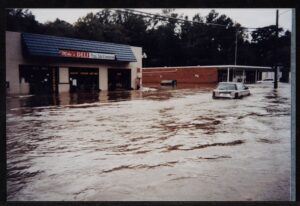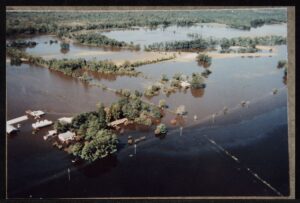The Flood of the Century: 25th Anniversary of Hurricane Floyd Impacting Eastern North Carolina
Hurricane Floyd, which struck North Carolina in September 1999, is remembered as one of the most devastating storms in the state’s history. Making landfall near Cape Fear as a Category 2 hurricane, the storm unleashed catastrophic flooding across Eastern North Carolina, particularly in Pitt County. Although Floyd’s winds were not the primary threat, the unprecedented rainfall and subsequent flooding proved disastrous, impacting countless communities and leaving a legacy of destruction and resilience.
A Perfect Storm: Floyd’s Impact and Aftermath
The devastation caused by Hurricane Floyd was magnified by the fact that it struck just weeks after Hurricane Dennis, which had already saturated the ground across much of the region. When Floyd arrived, it brought relentless rains, with some areas receiving up to 20 inches in a single day. Rivers and creeks, including the Tar River that runs through Pitt County, quickly overflowed their banks. The resulting floodwaters submerged entire towns, homes, and farmlands, with many communities remaining underwater for days or even weeks.
In Pitt County, the Tar River crested at an unprecedented 29 feet, devastating Greenville and surrounding areas. Entire communities were submerged, and thousands of residents were forced to evacuate. Floodwaters damaged or destroyed more than 10,000 homes across the region, displacing thousands of people as essential services like water and electricity were disrupted for weeks. The National Guard and other emergency responders used helicopters and boats to rescue stranded residents. Across North Carolina, more than 50 lives were lost, many of them in vehicles as people attempted to navigate flooded roads.
Economic and Environmental Challenges
The economic toll of Hurricane Floyd was staggering. Damage estimates in North Carolina exceeded $6 billion, making it one of the costliest natural disasters in the state’s history at the time. The agricultural sector was hit particularly hard, with thousands of livestock drowned and vast swaths of cropland ruined. The environmental impact was also severe, as floodwaters carried contaminants, including waste from hog lagoons, pesticides, and industrial chemicals, into rivers and wetlands. Cleanup efforts stretched on for months, as communities grappled with both immediate and long-term challenges.
- Hurricane Floyd damage, Greenville, N.C.
- Boating through Hurricane Floyd’s floodwaters
- Aerial view of Hurricane Floyd’s floodwaters
- Library Street Flooding from Hurricane Floyd
- Mike’s Deli area after Hurricane Floyd
- Arial View of flooding after Hurricane Floyd
- Hurricane Floyd’s floodwaters in Kinston, N.C.
- Hurricane Floyd’s floodwaters in Ahoskie, N.C.
- Aerial view of Hurricane Floyd’s floodwaters in Tarboro, N.C.
- Flooded Car after Hurricane Floyd
Floyds Impact on East Carolina University

The East Carolinian Special Hurricane Recovery Edition, September 28, 1999. East Carolina University Campus Newspapers. UA50-05. University Archives, East Carolina University, Greenville, NC.
Hurricane Floyd’s impact on East Carolina University was profound. The campus experienced significant widespread flooding, particularly in the lower-lying areas of Greenville and campus buildings near the Tar River. Many of ECU’s campus buildings, including residence halls, academic buildings, and facilities, sustained water damage as flooding forced the evacuation of several thousand students and campus employees. The storm also disrupted university operations, leading to the cancellation of classes and events for several days.
A Symbol of Resilience: The Moved ECU Football Game
Amid the devastation, East Carolina University’s football team provided an unexpected source of hope and resilience. Scheduled to play against the Miami Hurricanes on September 25, 1999, the game could not be held in Greenville due to the widespread flooding and damage to Dowdy-Ficklen Stadium. Instead, it was moved to Carter-Finley Stadium in Raleigh, home of ECU’s in-state rival, NC State University. Despite the odds, the Pirates rallied to defeat Miami 27-23 in a thrilling comeback victory. The win became a powerful symbol of the region’s spirit and determination in the face of adversity.
Recovery and the Path Forward
In the years following Hurricane Floyd, Pitt County, and Eastern North Carolina have made significant strides in recovery and resilience. Efforts to improve flood management and disaster preparedness have been implemented, including the buyout of flood-prone properties and enhanced emergency response protocols. These measures aim to protect communities from future disasters and mitigate the impact of such events.
Today, more than two decades after Hurricane Floyd, its memory serves as a powerful reminder of the region’s vulnerability to natural disasters and the strength of its communities in overcoming challenges. The storm was a tragic chapter in the history of Eastern North Carolina, but it also highlighted the resilience and determination of its people. As the region continues to rebuild and strengthen its infrastructure, the legacy of Floyd remains one of both loss and the unyielding spirit to persevere and rebuild.
For more information about Hurricane Floyd and its impact on East North Carolina, see the following:









